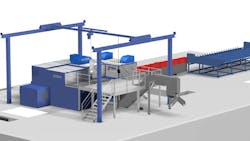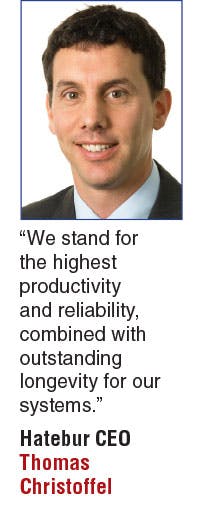Hatebur, the Swiss company that develops hot- and cold-forming processes and machinery, recently added a new model to its range of hot-forming systems. In its first application, the new AMP 50-9 has proven to be a highly productive system for processing heavy-duty roller bearings, with the flexibility to produce a wide range of other parts.
“In stark contrast to the situation in consumer product markets where the shelf life of new developments can sometimes be expressed in months rather than years, forming machines are designed to last for decades,” explained Thomas Christoffel, who became CEO of Hatebur Metalforming Equipment Ltd. last June. A mechanic by training, Christoffel studied engineering and earned an executive MBA, and has been with Hatebur since 1998. Starting his career there in technical customer service, in 2005 he switched to a role in sales before taking over as Sales and Marketing Division Manager at the start of 2013.
The primary example for group’s business philosophy is the Hatebur AMP 70, one model of which just completed its 50th anniversary in operation at SONA BLW Precision Forge in Remscheid, Germany. That plant specializes at manufacturing precision forged parts such as gear wheels and axle components for cars and trucks.
This particular AMP 70 – one of the first of its kind – has delivered more than 600 million forged parts since it started production in 1965. Featuring four forming stages, a stroke rate of 50-80 min-1 and a total forming force of 15,000 kN, this tireless workhorse can be used to produce a wide range of parts with diameters of up to 145 mm and weights of up to 5,000 g. It is slated to continue its service for quite a few more years to come thanks to thorough modernization measures such as the latest Hatebur control unit.
Reworking a proven design — “The main reason for getting to the drawing board for a major makeover of the well-proven AMP 50 XL was the desire to enhance its capacity,” according to Christoffel. The AMP 50 XL is effective for producing a broad range of hot-forged parts, with diameters of up to 104 mm and a maximum weight of 2,000 g. Its typical products are gear wheels, axles, flanges, and roller bearing rings.
A special variant of the machine, HFE, produces forward extruded parts, such stub axles. One particularity of this variant is the fact that the parts are held and transported by the narrowest section, not the widest section. The stroke rate can be varied between 60 and 100 min-1.
The AMP 50 is a versatile performer that is the centerpiece of manufacturing programs for forgers in many parts of the world. Over the years, many improvements have been implemented, such as a modern operator guidance system: commands are entered via a touchscreen, and the visualization of important process steps and key production figures provides a sophisticated base for economic production. Still, for a number of applications some users have wanted to operate at somewhat higher press loads.
Enhanced Power, Robustness with AMP 50-9
“These market requirements induced us to go back to the drawing board and design a more powerful variant, christened AMP 50-9,” Christoffel said. The primary new features include a higher press load of 9,000 kN, instead of the former 8,000 kN, and an increase in maximum part diameters from 104 to 108 mm.
The increase in forming force was taken into account by incorporating structural optimizations of the press body, widening the crank drive by 36%, and incorporating a larger, more robust first forming station. All these were achieved while maintaining compatibility with modern AMP 50 XL machine variants with respect to the tools for the three other forming stations. Thus the related tool sets can be fully applied to the new plant.
For the user, the enhanced forming power means he now disposes of a more versatile plant that provides even greater flexibility in all ranges of parts with exactly the same high level of output. Other features include a very sturdy bar feed driven by a well-proven servo axle, which in combination with the ESA 600 electronic bar end eliminator results in better process reliability, as well as material and energy cost savings. In developing the new system, particular attention was paid to extending the range of forged parts and to the cost-effective production of roller bearings in the “combined ring process.” Of course, the new AMP 50-9 is also available with the HFE option.
Additional changes have been made to ease maintenance work and reduce the related expense, for example by significantly improving access to the drive of the part-transfer system, and therefore making it easier to carry out maintenance on this critical unit.
Producing bearing rings — “Among the focal points when designing the new model was the enhancement of its capability for producing two bearing rings in one operating sequence,” Christoffel revealed. This “combined ring process” has a long tradition at Hatebur and makes it possible to produce two bearing rings from one cut-off. Since its inception it has undergone considerable development to make the process more reliable and the tool design simpler.
The process starts with fully drawing out a combination ring in the first two stations, followed by punching out the central hole in the third stage, and separating the inner and outer ring in the last station. After separation, the tool packet pushes out the inner ring on the die side, while the outer ring is stripped off on a plate. So, the two good parts are reliably separated within the machine before being gently discharged.
Since its introduction this operational sequence has been demonstrated millions of times, and now it has been consistently applied to the AMP 50-9. The enlarged crank assembly transmits the pressing load of the individual stations directly onto the crankshaft, and thus optimizing the process in combination with the larger tool holder in the first station.
Market-oriented development — “Our first customer for the AMP 50-9, already an experienced operator of Hatebur forming machines, has been quickly won over by its comprehensive set of features offering a clear added value,” Christoffel reported. This success underscores the validity of Hatebur’s business philosophy of carefully monitoring market developments and customer needs, and then developing equipment to address those opportunities. The development of the new AMP 50-9 demonstrates such an approach: an established technology has been optimized in terms of floor space, and the proposed conveying concepts made even more robust. For particularly demanding forged parts, new output variants with significantly smoother parts handling are available as an option.
Klaus Vollrath writes on technical and industrial processes from Aarwangen, Switzerland. Contact him at [email protected]

